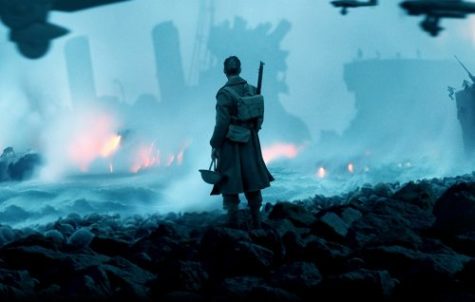Christopher Nolan captures the historic importance of humanity in Dunkirk
September 1, 2017
Christopher Nolan’s most recent release, Dunkirk, tells the tale of a historic military evacuation called Operation Dynamo, where over 300,000 soldiers were evacuated by fleets of small ships and destroyers. The movie followed a trio of soldiers named Tommy (Fionn Whitehead), Gibson (Aneurin Barnard), and Alex (Harry Styles).
Nolan captured each aspect of the event in Dunkirk, deciding to cut the movie into three parts: The Mole, The Sea, and The Air.
In the mole sequence, the movie solely focused on the soldiers and how hectic life was on the beach. It captured numerous bombings from the German planes and showed how desperate people were for safety.
The sea sequence focused on the civilian boats and their effort to transport as many people off the beach as possible. This sequence approached the prosperity and ethics of sailors at sea. The mindset of selflessness was captured, and not one line of dialogue was needed to prove that.
Last, the air sequence, which was one of my favorites, revolved around three pilots who would target the German bombers and stop the bombing of the beach of Dunkirk. I felt a rush of energy in my blood during these scenes, exactly like the pilots would have. I was cheering the pilot on when they would successfully down an enemy gunner.
Nolan did an incredible job capturing the emotions of each soldier. Without dialogue or context, you can tell these men have seen it all. The simplicity of this is a concept to admire, being able to release such emotion without speaking, only with a face.
Unlike other war movies, Dunkirk swam in diversity. In specific scenes I saw a lot of black soldiers which made me smile, because they made many exceptional efforts throughout the World Wars, but have not been credited. Seeing their presence and the director acknowledging this made me happy. Nolan did his research and made that known.
The visuals of this movie were something else to appreciate. With the amount of water and sky that is sees, Nolan capitalized to make each body of water and each piece of sky better than the last. Put the dull colors of the soldier’ uniforms and the charcoal grey clouds surrounding the radiant blue sky, and audiences have a cinematic masterpiece.
More importantly, I appreciated the lack of dialogue in the movie. It reminded me of grunt talk, keeping it rough and to the point. There wasn’t a need for 10 minutes of dialogue for in every scene to know what was happening.
Dunkirk stands up against most war films and newer releases, but the uniqueness of capturing and teaching an audience about an event that most people don’t know about is what I admired most. With a tear jerking ending, it’s easy to say this movie was a learning process and went in depth about life of war, which everyone should be informed about.


